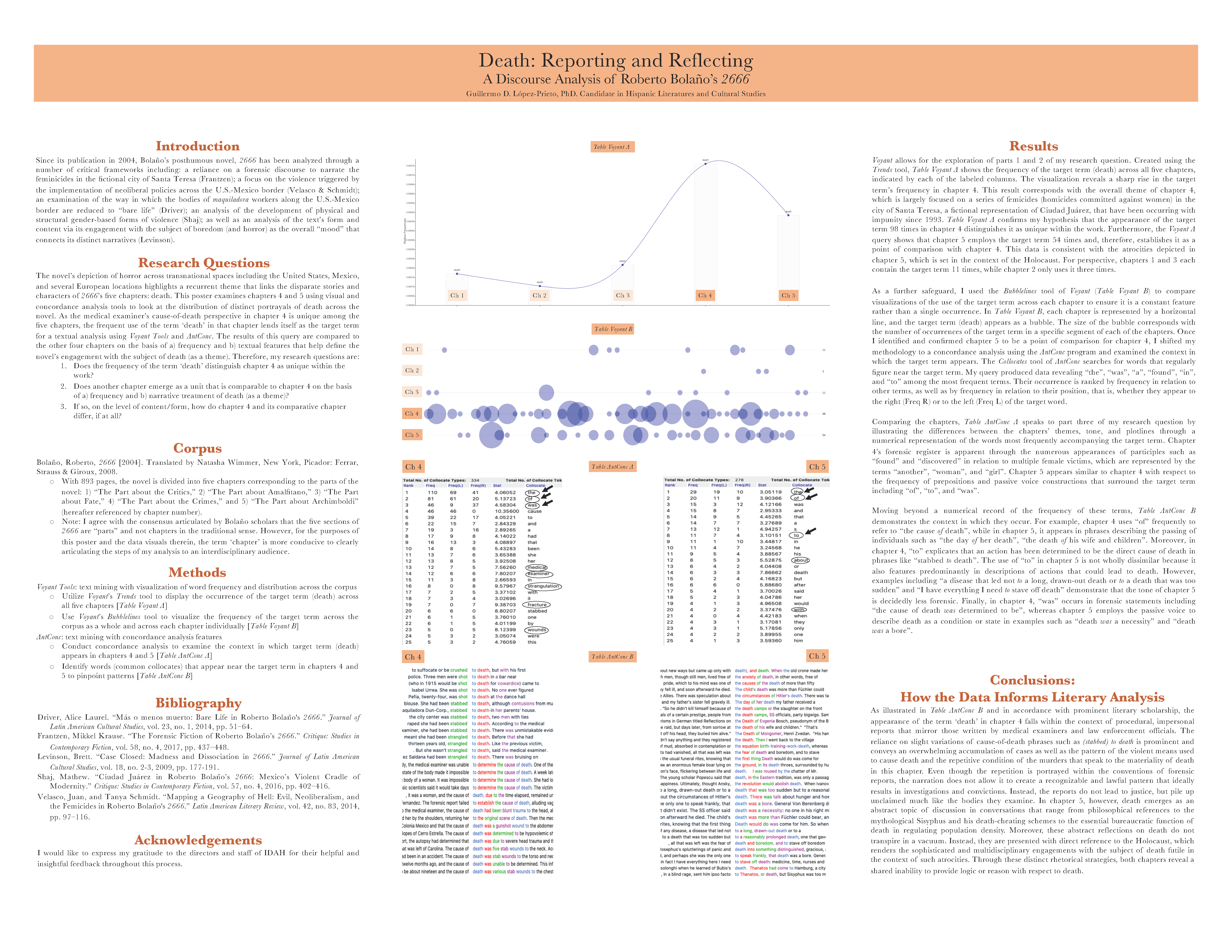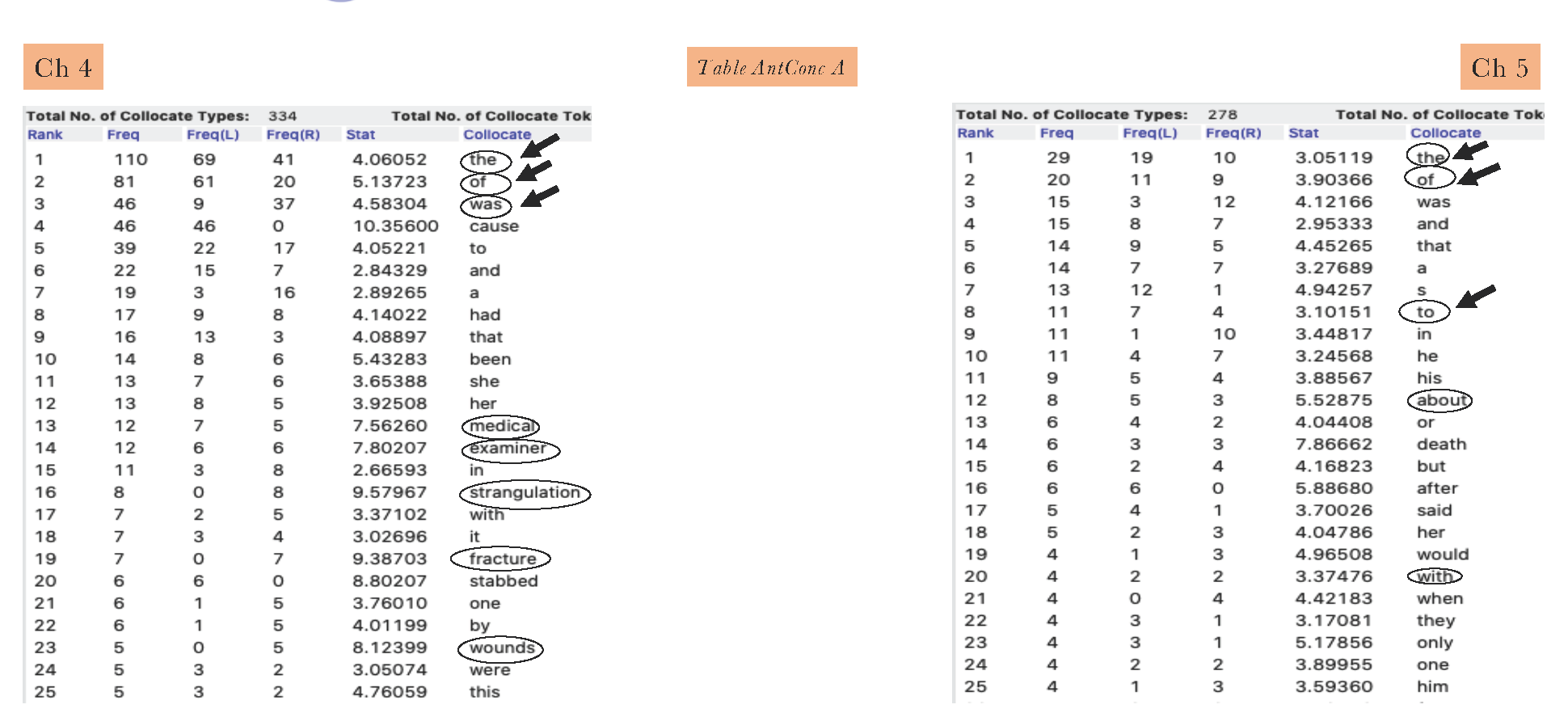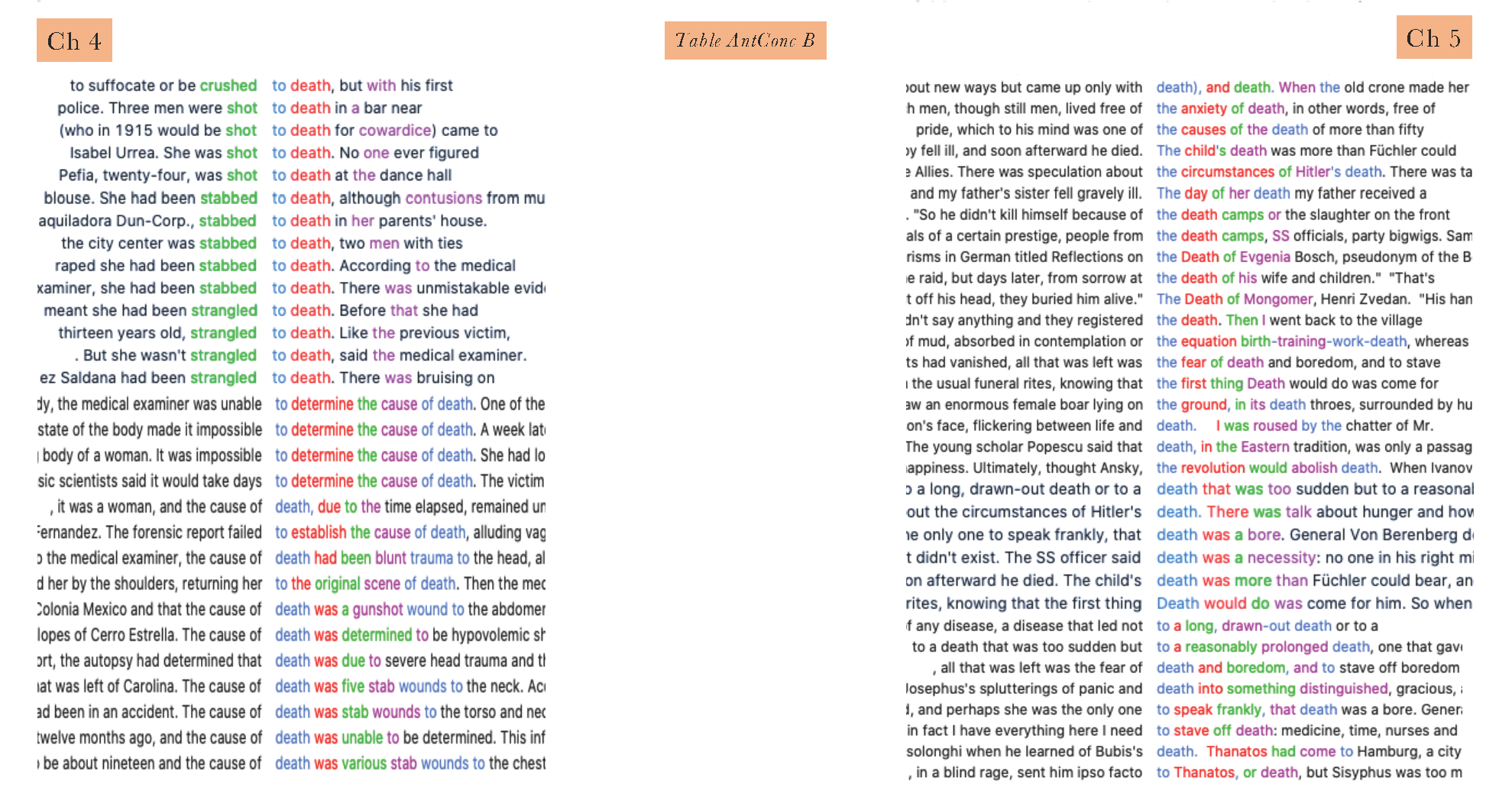DEATH: REPORTING AND REFLECTING - A DISCOURSE ANALYSIS OF ROBERTO BOLAÑO'S 2666
 Guillermo Lopez-Prieto's original Spring Symposium poster. Below is a word-for-word transcription of the poster material plus larger-format graphs for readability.
Guillermo Lopez-Prieto's original Spring Symposium poster. Below is a word-for-word transcription of the poster material plus larger-format graphs for readability.
INTRODUCTION
Since its publication in 2004, Bolaño’s posthumous novel, 2666 has been analyzed through a number of critical frameworks including: a reliance on a forensic discourse to narrate the feminicides in the fictional city of Santa Teresa (Frantzen); a focus on the violence triggered by the implementation of neoliberal policies across the U.S.-Mexico border (Velasco & Schmidt); an examination of the way in which the bodies of maquiladora workers along the U.S.-Mexico border are reduced to “bare life” (Driver); an analysis of the development of physical and structural gender-based forms of violence (Shaj); as well as an analysis of the text’s form and content via its engagement with the subject of boredom (and horror) as the overall “mood” that connects its distinct narratives (Levinson).
RESEARCH QUESTIONS
The novel’s depiction of horror across transnational spaces including the United States, Mexico, and several European locations highlights a recurrent theme that links the disparate stories and characters of 2666’s five chapters: death. This poster examines chapters 4 and 5 using visual and concordance analysis tools to look at the distribution of distinct portrayals of death across the novel. As the medical examiner’s cause-of-death perspective in chapter 4 is unique among the five chapters, the frequent use of the term ‘death’ in that chapter lends itself as the target term for a textual analysis using Voyant Tools and AntConc. The results of this query are compared to the other four chapters on the basis of a) frequency and b) textual features that help define the novel’s engagement with the subject of death (as a theme). Therefore, my research questions are:
- Does the frequency of the term ‘death’ distinguish chapter 4 as unique within the work?
- Does another chapter emerge as a unit that is comparable to chapter 4 on the basis ofa) frequency and b) narrative treatment of death (as a theme)?
- If so, on the level of content/form, how do chapter 4 and its comparative chapter differ, if at all?
CORPUS
Bolaño, Roberto, 2666 [2004]. Translated by Natasha Wimmer, New York, Picador: Ferrar, Strauss & Giroux, 2008.
- With 893 pages, the novel is divided into five chapters corresponding to the parts of the novel: 1) “The Part about the Critics,” 2) “The Part about Amalfitano,” 3) “The Part about Fate,” 4) “The Part about the Crimes,” and 5) “The Part about Archimboldi” (here after referenced by chapter number).
- Note: I agree with the consensus articulated by Bolaño scholars that the five sections of 2666 are “parts” and not chapters in the traditional sense. However,for the purposes of this poster and the data visuals therein, the term ‘chapter’ is more conducive to clearly articulating the steps ofmyanalysisto an interdisciplinary audience.
METHODS
VoyantTools: text mining with visualization of word frequency and distribution across the corpus
- Utilize Voyant’s Trends tool to display the occurrence of the target term (death) across all five chapters [Table Voyant A]
- Use Voyant’s Bubblelines tool to visualize the frequency of the target term across the corpus as a whole and across each chapter individually [Table Voyant B]
AntConc: text mining withconcordance analysis features
- Conduct concordance analysis to examine the context in which target term (death) appears in chapters 4 and 5 [Table AntConc A]
- Identify words (common collocates) that appear near the target term in chapters 4 and 5 to pinpoint patterns [Table AntConc B]
RESULTS

Table Voyant A
Voyant allows for the exploration of parts 1 and 2 of my research question. Created using the Trends tool, Table Voyant A shows the frequency of the target term (death) across all five chapters, indicated by each of the labeled columns. The visualization reveals a sharp rise in the target term’s frequency in chapter 4. This result corresponds with the overall theme of chapter 4, which is largely focused on a series of femicides (homicides committed against women) in the city of Santa Teresa, a fictional representation of Ciudad Juárez, that have been occurring with impunity since 1993. Table Voyant A confirms my hypothesis that the appearance of the target term 98 times in chapter 4 distinguishes it as unique within the work. Furthermore, the Voyant A query shows that chapter 5 employs the target term 54 times and, therefore, establishes it as a point of comparison with chapter 4. This data is consistent with the atrocities depicted in chapter 5, which is set in the context of the Holocaust. For perspective, chapters 1 and 3 each contain the target term 11 times, while chapter 2 only uses it three times. Table Voyant B
Table Voyant B
As a further safeguard, I used the Bubblelines tool of Voyant (Table Voyant B) to compare visualizations of the use of the target term across each chapter to ensure it is a constant feature rather than a single occurrence. In Table Voyant B, each chapter is represented by a horizontal line, and the target term (death) appears as a bubble. The size of the bubble corresponds with the number of occurrences of the target term in a specific segment of each of the chapters. Once I identified and confirmed chapter 5 to be a point of comparison for chapter 4, I shifted my methodology to a concordance analysis using the AntConc program and examined the context in which the target term appears. The Collocates tool of AntConc searches for words that regularly figure near the target term. My query produced data revealing “the”, “was”,“a”, “found”, “in”, and “to” among the most frequent terms. Their occurrence is ranked by frequency in relation to other terms, as well as by frequency in relation to their position, that is, whether they appear to the right (Freq R) or to the left (Freq L) of the target word.
 Table AntConc A
Table AntConc A
Comparing the chapters, Table AntConc A speaks to part three of my research question by illustrating the differences between the chapters’ themes, tone, and plotlines through a numerical representation of the words most frequently accompanying the target term. Chapter 4’s forensic register is apparent through the numerous appearances of participles such as “found” and “discovered” in relation to multiple female victims, which are represented by the terms “another”, “woman”, and “girl”. Chapter 5 appears similar to chapter 4 with respect to the frequency of prepositions and passive voice constructions that surround the target term including “of”, “to”, and “was”.
 Table AntConc B
Table AntConc B
Moving beyond a numerical record of the frequency of these terms, Table AntConc B demonstrates the context in which they occur. For example, chapter 4 uses “of” frequently to refer to “the cause of death”, while in chapter 5, it appears in phrases describing the passing of individuals such as “the day of her death”, “the death of his wife and children”. Moreover, in chapter 4, “to” explicates that an action has been determined to be the direct cause of death in phrases like “stabbed to death”. The use of “to” in chapter 5 is not wholly dissimilar because it also features predominantly in descriptions of actions that could lead to death. However, examples including “a disease that led not to a long, drawn-out death or to a death that was too sudden” and “I have everything I need to stave offdeath” demonstrate that the tone ofchapter 5 is decidedly less forensic. Finally, in chapter 4, “was” occurs in forensic statements including “the cause of death was determined to be”, whereas chapter 5 employs the passive voice to describe death as a condition or state in examples such as “death was a necessity” and “death was a bore”.
CONCLUSIONS: HOW THE DATA INFORMS LITERARY ANALYSIS
As illustrated in Table AntConc B and in accordance with prominent literary scholarship, the appearance of the term ‘death’ in chapter 4 falls within the context of procedural, impersonal reports that mirror those written by medical examiners and law enforcement officials. The reliance on slight variations of cause-of-death phrases such as (stabbed) to death is prominent and conveys an overwhelming accumulation of cases as well as the pattern of the violent meansused to cause death and the repetitive condition of the murders that speak to the materiality of death in this chapter. Even though the repetition is portrayed within the conventions of forensic reports, the narration does not allow it to create a recognizable and lawful pattern that ideally results in investigations and convictions. Instead, the reports do not lead to justice, but pile up unclaimed much like the bodies they examine. In chapter 5, however, death emerges as an abstract topic of discussion in conversations that range from philosophical references to the mythological Sisyphus and his death-cheating schemes to the essential bureaucratic function of death in regulating population density. Moreover, these abstract reflections on death do not transpire in a vacuum. Instead, they are presented with direct reference to the Holocaust, which renders the sophisticated and multidisciplinary engagements with the subject of death futile in the context of such atrocities. Through these distinct rhetorical strategies, both chapters reveal a shared inability to provide logic or reason with respect to death.
BIBLIOGRAPHY
Driver, Alice Laurel. “Más o menos muerto: Bare Life in Roberto Bolaño's 2666.” Journal of Latin American Cultural Studies, vol. 23, no. 1, 2014, pp. 51–64.
Frantzen, Mikkel Krause. “The Forensic Fiction of Roberto Bolaño’s 2666.” Critique: Studies in Contemporary Fiction, vol. 58, no. 4, 2017, pp. 437–448.
Levinson, Brett. “Case Closed: Madness and Dissociation in 2666.” Journal of Latin American Cultural Studies, vol. 18, no. 2-3, 2009, pp. 177-191.
Shaj, Mathew. “Ciudad Juárez in Roberto Bolaño’s 2666: Mexico’s Violent Cradle of Modernity.” Critique: Studies in Contemporary Fiction, vol. 57, no. 4, 2016, pp. 402–416.
Velasco, Juan, and Tanya Schmidt. “Mapping a Geography of Hell: Evil, Neoliberalism, and the Femicides in RobertoBolaño's2666.” Latin American Literary Review, vol. 42, no. 83, 2014, pp. 97–116.
ACKNOWLEDGEMENTS
I would like to express my gratitude to the directors and staff of IDAH for their helpful and insightful feedback throughout this process.

